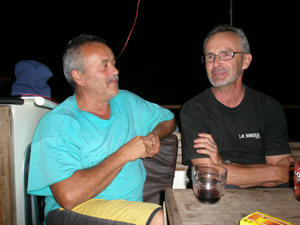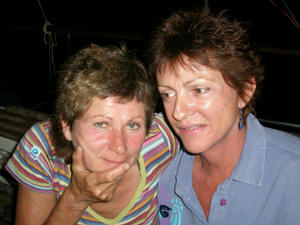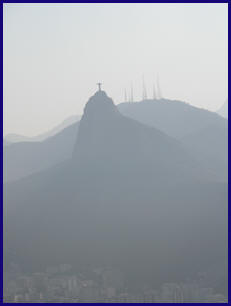
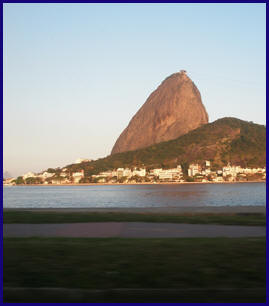 |
We had decided to fly from Yorkshire down to Heathrow. Booked well in
advance at about ú50 each it was a cheapish flight, and no more expensive
than the fuel and the day's car hire we would save. That was until British
Midland hit us with a charge of nearly ú200 for excess baggage! This
was because British Midland's baggage allowance was lower than
British Airway's allowance for the flight to Brasil. Does this seem fair?
Of course not, but when you are standing at the check-in desk you have no other
choice but to pay. Next time we'll drive. Long flight to Sa§ Paulo, long bus ride to Parati and 38 hours after leaving Lindy's mum's house in Pudsey we step aboard Samarang. Shortly before we returned we'd received an e-mail from Andre, who was keeping an eye on the boat for us, to say that there were problems with the batteries. By chance our friends Werner and Emmy on Afun Davu were close by so we'd asked them to go aboard and see if they could solve the problem. They were able to confirm that something indeed was wrong with the batteries. We'd had a small problem with our main Inverter/Charger for a while, so we assumed there was a linkage to the new problem. Werner was able to bring our second charger on line, but he was sure that at least some of the batteries were finished. This would entail replacing the whole set and from the sounds of it the Inverter/Charger as well. Hurrah! |
|
The first task was to try and locate suitable batteries - 4 x 220AH deep cycle batteries would not be easy to find in Brasil. In fact impossible would turn out to be more accurate. We did finally track down some very expensive, electrically smaller but physically larger batteries (and what a BIG difference 5mm can make when fitting them into the original frame). They weren't particularly suitable, but our choices were pretty limited. We had to have batteries. The Inverter/Charger was even more difficult. Nothing like a suitable unit existed in Brasil. Victron, the manufacturer of our existing unit, were being real stars as always, and as they didn't have a agent in South America were offering us a fantastic deal on a replacement unit. The only problem was that Brasilian import duty is 80% charged on the List Price + shipping costs of any item. We would run on our back-up unit for now and try to arrange the import in either Rio or Salvador where "ship stores in transit" might be understood. All this had taken more than a month and it was then that Luiz, the marina manager, mentioned in passing that one of the yachts on our pontoon had been struck by lightning whilst we were away!!!! Though they weren't sure which one. Could it have been us, could this be the cause of our problems? Straight back to the boat to run through the electronics. If we had been struck by lightning some of the other equipment would have been taken out as well. Radar - OK, GPS - OK, AIS - OK, VHF and HF radios - OK. Phew, wasn't us then. Actually, it would transpire that it was indeed Samarang that had been struck by lightning. A more thorough check revealed that both radios were working with only very limited range. There were dealers for both units in Rio, so after a final barbeque on the beach followed by a late night of drinks on board with Werner and Emmy, we set sail for Rio.
|
|
|
|
|
![]()
| Parati to Rio is a pretty windless stretch of coast so we expected to motor most of the way, but then the engine began to overheat. Probably not a serious problem, just a clogged heat exchanger, but not something we wanted to tackle at sea if we could avoid it. At least as things were we could probably run for 5 or 10 minutes in an emergency or to manoeuvre whilst anchoring, but if we stripped it down and couldn't fix it....... | |
| As it was, our maximum wind speed was 35
knots with squalls - so we sailed without much problem overnight and the
following afternoon entered one of the world's busiest harbours, across the
shipping lanes under sail and without much wind, and arrived at the anchorage of Charitas on the other side of the bay
from Rio just before dark. The following day we removed the heat
exchanger. Clube Naval Charitas is magnificent. It has restaurants, swimming pools, work shops, (note the plurals). It has a gym, security, nursing staff, video rooms, WiFi, etc, etc. All for a couple of quid a day. It also has completely free of charge, Susie and Renato - two Brasilian circumnavigators who now live aboard permanently in the club. Susie knows where everything is and nothing is too much trouble. Charitas itself is up-market and "tranquilo" and only a short hydrofoil ride across the bay from Rio. Rio is Rio, Copacabana is a beach, Ipanema is another beach. They were both a bit underwhelming - miles of golden sand facing the Atlantic of course, beautiful and decidedly unbeautiful oily bodies of course. Though I think we were a little surprised by the high proportion of the decidedly unbeautiful variety - Rio is a town where even hippos wear thongs!. But most disappointingly, virtually nothing else. Apart from the odd beach bar nothing. Not one single restaurant overlooking the beach, nowhere you could sip a pi˝a colada and watch the world go by. |
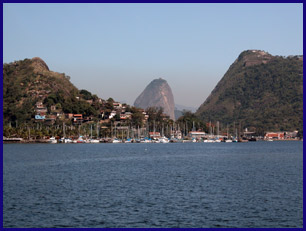 |
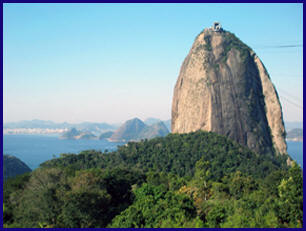 |
All that said though, we liked Rio. We did
the touristy things. We went up the Pa§ Azucar. And we shopped for
capacitors - well tourists we may be, but tourists with a generator. We had also tracked down the Icom dealer (superb) who after two days work finally took the cover off the antenna tuner to reveal.......Toast! There was no doubt now that we'd taken a lightning strike. The Icom guys fitted a new tuner and we were back in business. The Simrad dealer was distinctly less impressive. We tracked him down in a decrepit high rise block. He had one desk, piled high with unopened mail, in a smelly room behind an unmarked door and seemed shocked to see a customer. We had to ring him from the corridor to get him to open the door. We glanced at each other and without a word unanimously demurred from giving him our VHF radio. We took a taxi instead back to the marina where we bought a replacement local unit. Back in Charitas Susie took us to a little visited hill in Charitas where you have probably the best view of sunset over Rio that it's possible to have. |
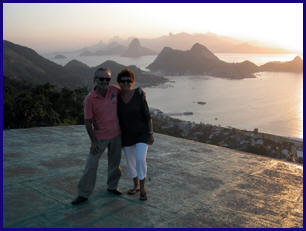 |
|
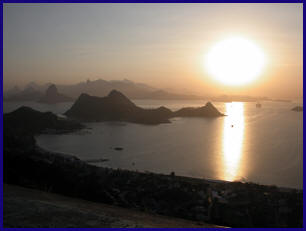 |
| The only thing we'd been unsuccessful in achieving was the importation of the new unit from Victron. It was going to be a complicated and lengthy process. It was already well into August, getting late in the season, and we really needed to head north before we lost all hope of southerly winds. So, with a fair amount of regret, we hauled our anchor at Charitas and headed towards the twin challenges of Cabo Frio and Cabo Sa§ Tome. We'd rounded them both before of course, but last time we'd had both the wind and current in our favour. This time it would be different. |
||
![]()
| We rounded Cabo Frio without much problem. It was lumpy of course, we
had a bit more wind than we would like, but the up side of this was that we were
making good progress. Barry was resting below, Lindy on watch and she
came down to say she was putting in another reef. And then there was a
deafening crash. The sort of crash for which even an angel can only utter
an obscenity. We rushed on deck. Had we struck a container? It
took a pause of seconds, though the adrenaline made it seem like minutes, to
realise what had happened. The backstay had parted at the top of the mast
and had crashed onto the deck. For the non sailors - The backstay is the steel cable that connects the top of the mast to the back of the boat and is integral in holding the mast up. For the avoidance of doubt, losing your backstay is bad and losing your backstay in 28 knots of wind and a steep sea is very bad. Pandemonium breaks lose. We haven't practiced this or even talked about it. The mast is waving about in an sickening way. It looks impossible that it can survive. The forestay is banging from side to side against the pulpit. Start the engine to give us steerage. Hope the heat exchanger doesn't block again. Roll up the remains of the Genoa. Get on the running backstays. It's been a while since we've used them - step by step, think it through, we can't have any mistakes. Get the topping lift tied to the bridle of the backstay and tighten it down. Should have done that before the runners - too late now. The mast is more stable now. Still waving about a bit, but it looks like we've saved it. Tidy away the main. Use the main halyard to provide more support. Better. Plot a course and start to motor slowly towards the nearest harbour, Buzios, 25 miles, but we should be OK. Team deep breaths, team hugs and then the dolphins appeared. How do they know?? It was dark when we arrived at Buzios, but we'd been there before - if you've read earlier pages you may remember that last time we got tangled in a fishing net on our way into the bay. No such additional excitement this time and using GPS we dropped our anchor exactly where we dropped it on our last visit. The following morning we were able to investigate the rig failure. One of the insulators which allow us to use our backstay as a radio antenna had split. These are designed to be stronger than the steel cable they isolate, so the failure was almost certainly lightning related. Buzios is principally a seaside town where the wealthy of Rio come for holidays. It has a yacht club, or rather it has a few expensive buoys, and a restaurant but we weren't at all hopeful that it would be much help in solving our problem. A long slow motor back to Rio might be our best solution. Anyway it's Sunday so not much can be done except sort out the mess left by yesterday's excitement and recharge our personal batteries. But we did go over to the yacht club. "We've broken our backstay. Do you have a rigger here? Or someone who can get us one of these?" (we presented the broken isolator). Amazingly, the answer was an unequivocal yes. One phone call and twenty minutes later along bounced Bambino. Short, tubby, bubbly and with a habit of calling everyone Bambino (or, of course, in Lindy's case Bambina), from where he acquired his nickname. Yes, he was a rigger, he was also a welder with MIG and TIG equipment, and he had a machine shop. He didn't know if we could source appropriate spares in Brasil, but if we let him take the old one, he'd call around on Monday morning and get back to us to let us know what the options were..... And he did. The isolators weren't available in Brasil so would need to be imported, expensive and say realistically 2 or 3 weeks. He could remake the backstay without the isolators. It looked as if the steel cable and terminals were available - it would be very expensive, because all of the parts were imported and would involve a trip to Rio or Sa§ Paulo for him, so probably similar timescales. Finally, he suggested making stainless steel copies of the isolators in his workshop - they obviously wouldn't isolate anymore, but they'd be very strong and I could easily rig up a wire antenna. Time scales? Price? We wanted to know. Tomorrow and the equivalent of ú100 . For ú15 more he'd also do the installation and we agreed he would also make us a lightning conductor (stable door, horses??). So by Wednesday evening we're ready to go sailing again. A minor miracle. In the meantime we'd also tracked down StaLock who make the isolators. They didn't have an agent in Brasil of course. StaLock have a great reputation so this should be easy. We mailed their UK and US offices explaining our predicament and asked how we could arrange shipping replacements. To date, four months later, we have still had no reply from either location. A big thanks to StaLock! A couple of days sail up to Guarapari for an overnight stop, then on to Vitoria. We know better this time not to use their horribly exposed visitors berths and instead pick up a buoy in the small bay behind the yacht club. The yacht club has however built a new basin with impressive pontoons. They had no cleats and weren't useable when we were there in September, but all the hard work was done, so by now they should be fully functional. Vitoria seemed just as nice as first time around so we do some shopping, including unsuccessful capacitor shopping of course, and also get the big outboard fixed for the third time (we won't bore you with that story) while waiting for the next southerly front to arrive. Then we're off north again towards the whale breeding grounds around the Abrolhas. We were too late for the whales on the way down last year but it's early September and there should still be plenty left so we are determined to stop there for a few days to go whale spotting. There are plenty of the big chaps in evidence as we approach the islands, but mostly in the distance. When we do arrive at the Abrolhas, it's dark, moonless, raining and windy. The Abrolhas are not lit in any way. We try to work our way in, but it's very black and too scary, so in the end we have no choice but to re-hoist the sails and continue northwards.
|
|
| In the morning we do have a close'ish
encounter with a whale, though at first we're not aware of it. We
don't recognise it at first. We see something in the distance. Is it
a ship, a yacht, a buoy? No, actually it's a completely stationary
whale tail upside down with it's head and half it's body under the
water. It seems to be standing on it's head.
It doesn't move as we continue to close on it. Then finally it dives, but
only for a minute or so and then it returns. Head down and tail up in the
air, as if on sentry duty. It's still there as we sail away. Another
of life's mysteries. Does anyone know why?? Our next stop is Morro Sa§ Paulo, where we anchor off Curral for a few last days of nature and peace, before reluctantly heading once more into Salvador. Not our favourite place, but we have business to attend to and not much time.
|
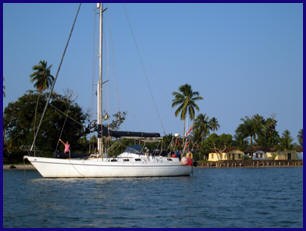 |
![]()
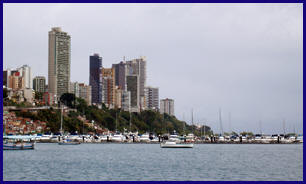 |
Salvador may indeed not be our favourite place, but we do know our way around
and go into semi-automatic for the first few day. Centro Nautico has been
renamed again. It is now Terminal Nautico de Bahia. In most other
respects it is just the same - Horrible, but right in the centre and where
all the other cruisers are moored. So, first a quick dash to Policia Federal and Capitan
dos Portos to get the formalities out of the way. This quick dash ends up taking two full days as we have to
visit each three times. Firstly, because of the infuriatingly different
application of regulations in different states means that the Bahian authorities
want different paperwork than the Rio authorities provide. And secondly, more
simply, because the offices simply aren't open when they're supposed to be.
However almost in parallel we organised sail repairs, gas bottle refills, antifouling, laundry and of course we washed the boat. We also visited the airport to extend our visas, visited our favourite Perini supermarket and began multiple trips to doctors, dentists and opticians. All of these with our newly adopted taxi driver - Cesar. |
| Of course we go shopping for capacitors, this time
successfully! And on the social side of things we contact Lesley & Eduardo. Lesley is
in the UK, but we arrange dinner with Eduardo. At the same time as all this we began the process of importing our new unit from Victron free of tax, utilising with some misgivings the services of our old "friend" Marcello. After a few administrative banking gremlins this begins swimmingly well, the inverter is despatched and arrives at Salvador airport a few days later, but of course this isn't going to last. On our first visit to customs we discover that Samarang is on a blacklist of vessels that have previously imported spares, but have not cleared either themselves or the parts out of Brasil. That's correct we say. It's because we're still here. "Ahha" say customs, then the vessel has been in Brasilian waters for more than 6 months. Correct again we say, pushing forward the appropriate sheet from our mountain of paper work - we were granted prorogation (an extension) for 2 years in Angra dos Reyes. A pause whilst they examine the papers and then - "Ahha" say customs and did you also apply for prorogation for the parts you imported? What?? We always provide customs with the complete portfolio of all our Brasilian papers. They copy what needs to be copied, take what needs to be taken and stamp what needs to be stamped. So surely prorogation of the vessel includes all of it's equipment?? Of course it does, says one customs official. Of course it doesn't, says another. There is much examination of large books and dusty documents. Eventually we are shuffled to another desk and are presented with a collection of incomprehensible documents in Portuguese and asked to sign them. We are naturally uncomfortable in doing so and Marcello is not really able to translate them except to say that they require us to pay the previous duty and a fine (a total of over $US4000), but have 14 days to mount a defence. We call Eduardo to ask who, in Lesley's absence, represents the British consul. He thinks probably we would need to contact Rio, but offers to help translate. He confirms what we have already understood, but that all we are being asked to sign is an acknowledgment that we have received the documents. He is "reasonably" confident that this can be sorted out and if we sign the acknowledgement and write a defence he will translate it for us. Though it will of course, Brasilian bureaucracy being what it is, take some time. We are to spend the next couple of weeks going backwards and forwards to the airport. No two departments in customs seem able to transfer any information so we keep having to provide additional copies of documentation they already have - even the documentation which they presented to us. An added "bonus" is that whilst the infraction is being investigated we cannot get our much needed Inverter released from customs under the 'vessel in transit' process. They do agree that it can be released if we pay the duty and perhaps because we have now generated some interest (and to be fair a little sympathy), the figure they come up with is based on the invoice rather than the list price. The opportunity to pay them R1300 and walk out, carrying our boxes from Victron, seems too good to miss compared to our other problems - so we pay up, smile and leave with the goods. A couple of weeks later we are cleared of any wrong doing. The official finding is that the various customs offices that dealt with our paperwork (naturally with the exception of the office at Salvador airport) were wrong not to have also stamped the papers relating to our spares. Much signing in triplicate follows and all charges are quashed. So "Can you now refund the R1300 that we had to pay to get our inverter released?" The room goes dark as a huge flock of flying pigs pass by the window! Eduardo summed it up - We call customs here 'The Lion' and what The Lion has eaten he never disgorges! At this time we are still trying to get the boat lifted and anti-fouled. Bahia Marina had an emergency lift to do and we missed our slot. Carlinho who is doing the work finally manages to wangle us a space. He's a star, such a delight to deal with after the grasping Marcello. We lift, three nights on the hard and back in the water. We've never done it so quickly. We even managed to fit a long awaited forward facing scoop on one of our inlets, which will allegedly solve the problem and allow us to make water whilst underway. The final jigsaw piece, before we can leave, is a pair of new glasses for Lindy. They had a flaw in the lenses. Essilor have remanufactured them, and the new ones have a different defect!! They have agreed to forward another new pair to Recife. So, after a final dinner with Lesley and Eduardo, we leave Salvador on 21st October to head north, much much later than planned. |
|
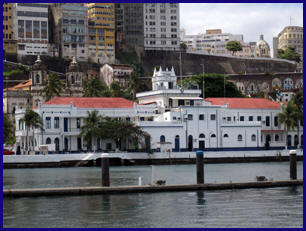 |
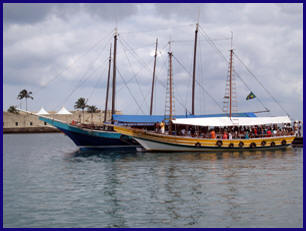 |
![]()
| For the next few hundred miles the log will be punctuated
with: "Unhelpful wind" "Sailing south to go north east" "Still can't sail the
course" "Motor sailing again" "Still no helpful current"
etc, etc.
But we grind our way slowly northeast. Once we reach Recife the coastline
is northerly and it will be better and once we reach Natal it will be north west
and we should start to pick up the Guyana current. All downhill from
there on - in theory anyway.
We anchor at Maceiˇ. It may be a charming place. We'll never know as we never found a way of getting ashore. We just stay two nights, rest and watch the weather forecasts. The wind looks slightly better, not good, but better and every day we wait the seasonal weather becomes less favourable, so we leave. Twenty miles before Recife is Suape which the pilot describes as 'the most beautiful anchorage in the area', though a tad tricky to enter. From what we can see across the reef it looks lovely. We try to nose in, but run aground twice. We debate what to do. We could anchor outside and use the dinghy to try and find a way through, but if we're unsuccessful we will have leave and will arrive in Recife in the dark. Something we always try to avoid in new busy harbours. So slightly reluctantly we set sail for Recife and by 1600 we have picked up a buoy outside Pernambuco Iate Clube, just ahead of another British yacht (the first we've seen for some time) called Penguin II. There are three yacht clubs in Recife, of which PIC is unarguably the least salubrious. We had originally intended to head for Cabanga Iate Clube which is the most luxurious and where every taxi driver in Recife will take you if you mention a 'yacht club'. None of them have heard of PIC, and with good reason. It's not really a yacht club at all. It's a restaurant on the sea wall reached by dirt road. There are a few buoys and a couple of boats pulled out on a piece of concrete along the bank of the river and a rickety pontoon. But Eduardo, who runs the place, and his side-kick El Negro (unsurprisingly a large black guy) are so friendly, enthusiastic and helpful we felt no desire to move once we'd arrived. Also Rob and Jean on Penguin had been in Recife for nearly 5 months and knew the place like the the back of their hands - and where to find all the things that sailors want - so almost immediately we felt at home. We really liked Recife. It hasn't got anything special to attract tourists and is dismissed by the Lonely Planet, but they're not sailors. It's a working town and you can find just about everything you could possibly want. It's laid out in a very traditional Brasilian/Portuguese way so that all the similar shops are grouped together. So there's hardware street, O ring street, filter street, plastic container street, refrigeration street, electronics street..... I could go on, but you probably get the drift by now. The only minor irritant was even more tedious bureaucracy than normal at the Capitan dos Portos. (We had cleared through to Natal, so wouldn't normally have troubled them, but Eduardo asked us to pay them a visit). They won't let Barry in because he's wearing shorts - even though the uniform of their own officers consists of shorts! Lindy in shorts is however acceptable so she goes in and Barry stands outside. They then insist that we visit the health authority to clear in. "But we've come from Salvador in Brasil, clearing health again isn't necessary." It's a pointless conversation, once a Brasilian 'functionario' has made a statement he will never change his stance, no matter how illogical that stance may be. It's not that it's a particularly big deal (Do you have any dead bodies on board? Do you have plague or rats? No & No. Stamp) It's just by the time we've trekked across town and found the Health Authority to jump through this hoop, Capitan dos Portos will be closed and we'll have to come back again tomorrow. Almost inevitably we'll then deal with a different 'functionario' who may well dream up another visit for us. But we're lucky and our papers are duly stamped. After a pleasant couple of weeks in Recife it's time to get going again and we head north to JacarÚ which has been given great reviews by everyone - both yachties and Brasilieros - and also comes highly recommended by Annie Hill in her book 'Brasil and Beyond'. Apart from anything else, it is home to the almost legendary Bryan Steves, an Englishman who settled there and started a boatyard 30 years ago. According to Annie and others we have met, he is one of the most helpful people they have ever met. According to others he's not there any more, but hibernating, too busy these days to talk to yachties, etc. Well we can report that Bryan is still there and that the boatyard is going strong. He's incredibly busy, but is always happy to find the time to chew the fat with any passing yachty of any nationality. And from what we saw, still prepared to do anything in his power to help a yachty with any sort of problem. So not only does the legend live, he also lives up to his reputation. And Jacare? Well things have changed since Pete and Annie Hill visited. It's moved a bit up-market and the waterfront is now lined with restaurants and bars. There's also now a marina operated by a French guy Philippe. It looks a little run down, though actually it's more that it's never been quite finished, but it's probably a safe enough place to leave the boat for a few weeks to go travelling and the options in this part of Brasil are extremely limited. It won't be cheap though. Philippe wanted 50 Euros a week for anchored boats to land their dinghies on his pontoon! (The yacht club pontoon 100 metres closer to town was free) He also wanted 50 cents per litre to deliver fuel to the quay - a service all the local garages would do without charge if you bought 100 litres. Again, we could go on..... we did wonder if Philippe had any connections with Marcello in Salvador.... All in all though JacarÚ is a really nice place to spend a couple of weeks, and we did - following Bryan's advice - eat the best Carne do Sol we have ever tasted in a very non-descript looking restaurant under a cashew tree. Though before you rush off to book a flight - one final word of caution. You will need to have a strong tolerance for Ravel's Bolero - every night, at sunset, a local saxophonist who is in the Guinness Book of Records for having played the tune more times than anyone else ever, continues to make sure that he will never be overtaken. So our Bolero tolerance having finally reached breaking point (and by the fact we still hadn't cleared in and the police would be coming round again on Sunday), we hauled our anchor once again and set off for Natal. |
![]()
| Natal. Well they've built a very, very big bridge which
wasn't on our pilot information, which is always a little disconcerting.
If you arrive here by boat, just head for the bridge and go through the
middle. We anchored
three times outside the yacht club. The navy moved us on the first time
and the yacht club the second time. Space was at something of a premium.
We later learned that we could have picked up one of the vacant buoys, but by
then we were set. The yacht club is a nice enough place, but not in the same
league as Charitas or Vitoria and much more expensive. They do
though have live music 3 nights a week, a pretty good band and a saxophonist
-
without Bolero! It is also a long way into town and taxis need to be
ordered from reception. We'll probably remember as a highlight a
very nice modern supermarket. Most of all though Natal yacht club is the
only place in all of Brasil that has managed to coordinate the bureaucracy to
make life almost easy for visiting yachts. They take your papers on
arrival and fax them to the relevant authorities. On departure they
contact Policia Federal who come to the club to clear you out and they call you
a taxi, whose driver knows the ropes, to take you to customs and Policia Maritimo.
He walks you in, straight up to the appropriate person in each case. No queuing, no waiting, no hassle. Perfect. It seems like some kind of
sick joke, that after a year of sailing in Brasilian waters and dealing with
their tortuous bureaucracy, at the very last place we will ever visit in Brasil,
we finally discover somewhere where the system has been tamed.
And with that we left to go to France for a few days. Well Guyana Franšais actually, but it is both part of France and part of the EU. But that's another story. |
